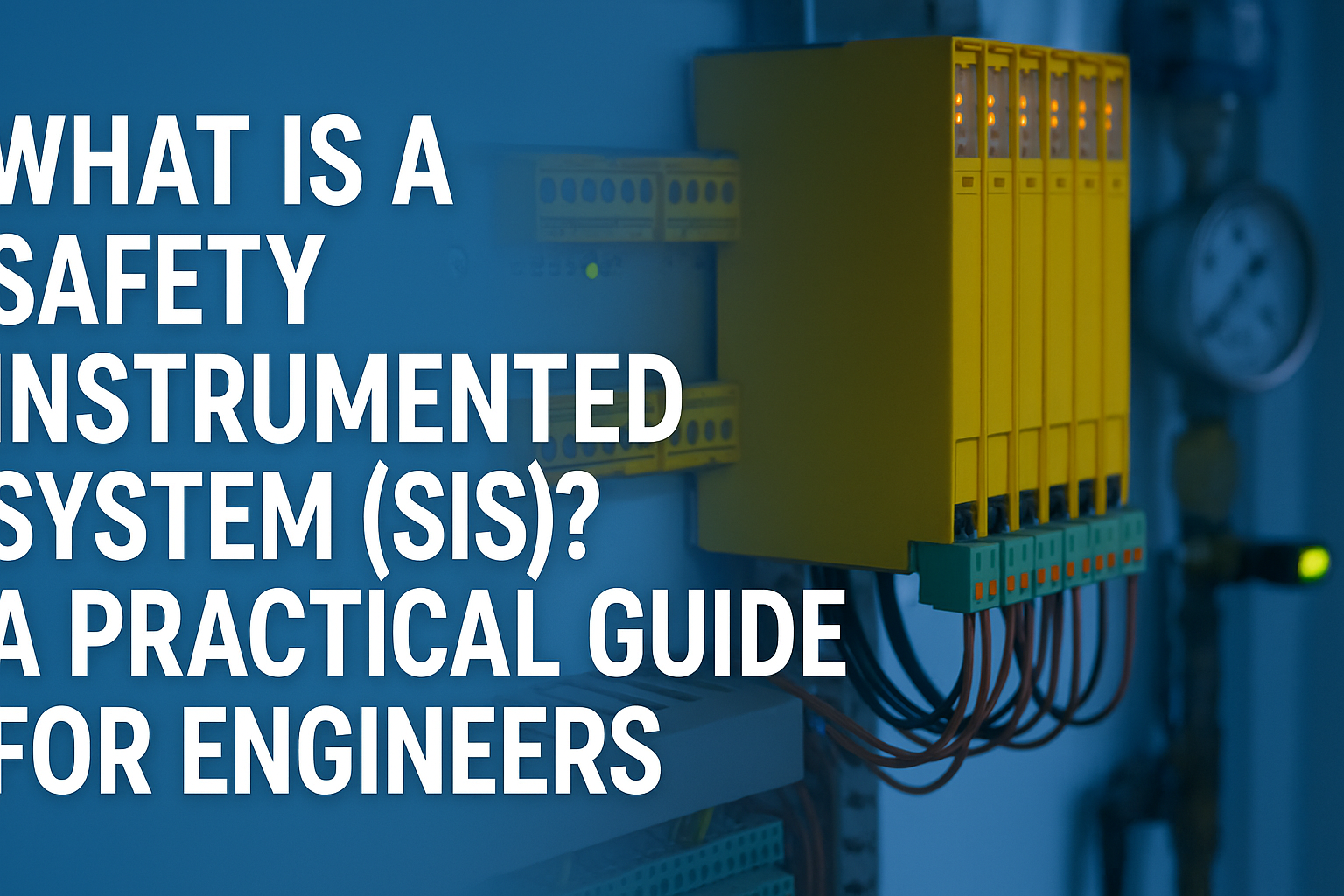 teddy@teddyele.com
teddy@teddyele.com +86 13968749891
+86 13968749891


 +86 13968749891
+86 13968749891

Aug 12,2025
In a complicated industrial process, the industrial workers keep an eye on tons of signals every moment. But have you ever wondered what would happen if the primary system failed? What’s the last line of defense safeguarding your people, your equipment, and the environment? Of course, it can happen, and it can be extremely dangerous.
In this ultimate guide, we'll clear the concept of the SIS. We'll break down what it is, its major components, and most significantly, show how fundamental electrical devices like circuit breakers form the critical 'muscle' of this safety brain.
A SIS is an individual safety setup that functions alongside the major control system. Consider the SIS as a safety watchdog that constantly keeps an eye on the whole system. However, when something bad happens, it takes action. In fact, even if the main control system ceases functioning, an SIS will be doing its work.
BPCS (The Basic Process Control System) is the basic system that operates the plant and keeps it going. It controls everyday tasks and adjusts equipment. Also, it continues the functioning process in a way that it is supposed to be. The main purpose and job are to ensure the production process runs flawlessly and stays within the limits.
The SIS is different. Its job is not to run the plant. Nonetheless, its job is to safeguard it. The SIS interferes when it sees that the BPCS is not able to control the situation. Or, the SIS comes when a dangerous situation is noticed. It functions totally opposite to the BPCS. Plus, it can handle the situation if the main system fails. The job of the BPCS is to run the process smoothly. While the SIS safeguards workers and equipment.
For example, let’s suppose the BPCS is the vehicle’s driver and SIS is the airbag. The driver takes control of the car the whole time he/she is driving. But as the car faces a road accident and crashes, and the driver (BPCS) is not able to do anything, then this airbag (SIS) comes forward and saves the driver (BPCS). The SIS and BPCS are also like this.
These devices measure the process (e.g., pressure, temperature, level, gas detectors). They are the input that detects a hazardous condition.
This is generally a dedicated PLC. It gets the sensors and, based on its programming, decides if a dangerous condition exists and what to do to handle it.
These are the electric systems that perform the command from the logic solver to bring the process to a safe state. For instance, safety valves, dampers, and the electrical parts that de-energize equipment.
SIL (Safety Integrity Level), which is used to determine how useful a safety system is when it comes to minimizing risks.
There are four levels of SIL. SIL 1 is the lowest, while SIL 4 is the highest. The higher the SIL, the more trustworthy the system must be, and the lower the chance it will fail when required. For instance, a system with a SIL 4 has extremely strict requirements. However, it is used in situations where just a little failure can cause serious damage. In short, a SIL requires SIS to handle the situations. However, SIS is stronger.
Standards like IEC 61508 and IEC 61511 is required for SIS and SIL. These standards are for electrical safety.
A safety system's logic is useless if its command can't be reliably executed. In countless applications, the safest state for a motor, pump, or heater is 'off.' The fastest, most reliable way to guarantee this is to cut the power.
The Safety PLC (logic solver) sends a signal to a shutdown trip or undervoltage to release the coil installed on an MCCB (Molded Case Circuit Breaker). This accessory acts as the interface, allowing the SIS to trip a robust, high-power electromechanical device. To measure voltage, you can buy an ammeter from this digital ammeter manufacturer with better pricing and quality.
· Reliability: Proven technology designed to operate under fault conditions.
· Speed: Trips in milliseconds.
· Power: Capable of interrupting immense electrical currents safely.
· Confirmation: Can be fitted with auxiliary contacts to send a signal back to the control system confirming it has tripped.
Choosing a high-quality MCCB from a trusted mini circuit breaker manufacturer is essential for the integrity of any SIS where electrical tripping is the final action.
Here is how an SIS functions in real-life scenarios:
Sensors in the SIS continuously measure pivotal parameters without any break. Some examples are:
· Temperature
· Pressure
· Flow Rate
· Gas Levels
For example, in a chemical plant, sensors rapidly find out if a reactor temperature is climbing too high.
· The SIS possesses safety limits in advance.
· If a reader goes beyond one of these limits, for instance, a boiler pressure goes above a safe threshold, the system recognizes it as a danger.
· The SIS logic solver (essentially the “brain” of the system) goes through sensor signals.
· It rapidly makes a decision whether the condition is dangerous enough to give a signal.
If a SIS determines that intervention is required, it sends signals to control the things. Those things are:
· Shutdown
· Valves
· Circuit breakers
In our boiler example, the SIS might:
· Shut down a steam supply valve.
· Close the burner.
· Turn on the emergency vent.
· After responding, the SIS ensures the process stays in a safe state until it’s examined by a human being (not by a machine) and restarted by trained staff.
· This could mean keeping equipment off, separating components of the plant, or balancing pressure relief.
· Oil and Gas: If a gas leaks, and the SIS catches it, it automatically closes the isolation valve and gives signals.
· Power Plants: If the turbine goes above its limit, the SIS shuts down one turbine to prevent sudden extreme failure.
· Chemical Making: If the temperature of the reactor becomes too intense, the SIS injects extremely cool.
Examine sensors, logic solvers, and final control things at planned gaps. See if there is any sign of damage, wear, or corrosion.
Test on some things to ensure whether the SIS responds correctly or not. Examine each Safety Instrumented Function separately.
Use updates that are recommended by manufacturers. This is to prevent bugs or security dangers. Make documents of all software changes for tracking.
Make sure readings are perfectly right, especially for those pivotal parameters. A few examples are:
· Pressure
· Sensor
· Document Everything
Stay updated about the detailed records of:
· Inspections
· Test Results
· Repairs
· Upgrades
If the documentation is good, it helps with audits and problem-solving.
Ensure the staff know how the SIS functions, how to check it, and what to do about the alarms.
Replace the parts on the recommendation of the manufacturer and do not wait for breakdowns.
Reassess safety limits to match ongoing process conditions or updated regulations.
Make sure that SIS parts are protected from dust, moisture, intense high temperatures, or vibration.
BPCS: The main control system that operates the plant's usual operations. Those operations include handling flow, temperature, and pressure.
SIS: An individual special safety system that comes forward only in the case of a dangerous situation.
BPCS: Continuously runs the process without any interruptions and without any normal operating limits.
SIS: Safeguards people, equipment, and the surroundings from dangers and risks by shutting down or controlling processes. All this happens when there is a dangerous condition in there.
BPCS: Works 24/7 to handle daily tasks.
SIS: Always stays on standby. Only turns on when there is danger.
BPCS: Specialty made for and quality control.
SIS: Made for trustworthiness. For example, even if the PBCS fails, SIS takes over the control.
BPCS: Is capable of sharing a few sensors and devices with other systems.
SIS: Must be separate from the BPCS so that if there is an issue in one system, there will be no harm to the other system.
BPCS: In a chemical plant, it handles the flow of raw materials into a reactor. So that the production doesn’t get affected.
SIS: If the reactor’s pressure gets extreme, it closes the valves and ceases the process to prevent an accident.
Read about different types of mini circuit breakers to understand which one to use for more safety.
In a Safety Instrumented System (SIS), sensors are like the eyes and ears of the operation. They constantly gather real-time data from the process of temperature, pressure, flow rate, gas concentration, and more. Here’s how they catch problems early:
Sensors work all the time, examining if each measurement stays within safe limits. They monitor and assess even the smallest changes.
As the temperature changes, the sensors notice instantly. The SIS doesn’t wait for the worst to happen; it detects the problems early.
As soon as the reading goes past the set limit, the sensor sends quick signals to the SIS brain. This happens within a second, so that the system can respond instantly.
Because it has built-in sensors, the SIS has the ability to trigger safety actions. Those actions can be closing the valve, ceasing the pump, or letting go of pressure.
SIS sensors are made and calibrated to filter out noise and catch only genuine and meaningful changes.
Learn about the differences of volmeter vs digital multimeter in great detail from here.
The SIS is a pivotal electrical device based on sensors that is responsible for safeguarding the people and equipment. It is made up of sensors and can detect a dangerous electrical situation. The reliability of this system is measured by its SIL level.
Ensuring the components in your safety system meet the highest standards is non-negotiable. If your application requires reliable electrical isolation as a final safety action, explore our range of high-performance MCCBs and compatible trip accessories, or contact our technical team to discuss your safety system's requirements.